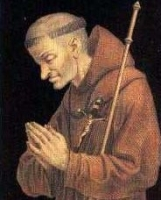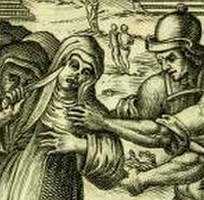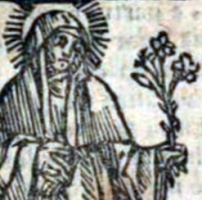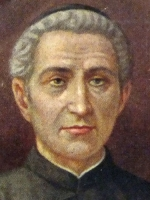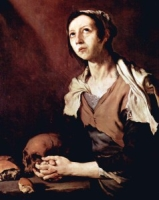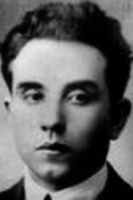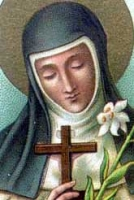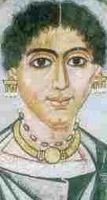St. Polycarp of Alexandria
Feastday: April 2
Death: 303
Martyr of Egypt. He was put to death at Alexandria, Egypt, during the persecutions under Emperor Diocletian. Polycarp was cruelly tortured and then beheaded.
The Holy Martyr Polycarp was killed after he denounced the impious Emperor Maximian (305-313) for shedding the blood of innocent Christians in the city of Alexandria. As a devout Christian who was filled with zeal for God, he could not simply stand by when every day he saw many of the faithful being tortured because they refused to deny Christ.
One day Saint Polycarp saw the ruler sitting in his chair and watching as the blood of Christians flowed like water. The Saint stood before him and questioned him saying, "Why have you so forgotten human nature, you insatiable dog, that you cut down your relatives and fellow countrymen with swords like wood, because they proclaim the one true God and refute the error of idolatry; just as I do, who am a servant of Christ?"
Because he angered the ruler by saying such things, Saint Polycarp was arrested and tortured. Finally, he was beheaded, dying with the name of Christ on his lips. By being cut down like a vine-branch, he offered much fruit to Christ, and received the crown of martyrdom
Bl. Severian Baranyk
Feastday: April 2
Birth: 1889
Death: 1941
Beatified: Pope John Paul II
Blessed Severian Stefan Baranyk (July 18, 1889 - 1941) was a Ukrainian Greek Catholic priest and martyr.
Severian Baranyk
Severian Stefan Baranyk (Ukrainian: Северіян Бараник; 18 July 1889 - June 1941) was a Ukrainian Greek Catholic priest and martyr.
Baranyk was born in Uhniv, Austrian Galicia (today Western Ukraine). He entered the monastery of the Order of St Basil the Great in Krekhiv in 1904. On May 16th he took his first monastic vows and then on 24 September 1910 he took his perpetual vows. He was ordained to the priesthood on 14 February 1915. Baranyk was known for his preaching, and his life was noted for his special kindness to youth and orphans. In 1932 he was made the prior (hegumen) of the Basilian monastery in Drohobych.[1]
On 26 June 1941 the NKVD (KGB) arrested him. He was taken to Drohobych prison and never seen alive again. After the Soviets withdrew from the city his mutilated body was found in the prison with signs of torture, including cross shaped knife slashes across his chest.[1]
He was beatified by Pope John Paul II on 27 June 2001.
Yasyf Lastoviak, in a testimony, recounted finding Stefan Baranyk's corpse. "Behind the prison I saw a big hole which has been covered up, filled with sand. when the Bolsheviks retreated, the Germans came and people rushed to the prison to find their relatives. The Germans allowed people into the area of the prison in small groups to claim their murdered relatives, but most people stood by the gates, so I went to the side and climbed a tree. there was a terrible stink... I saw how the Germans sent people to uncover the hole which was filled with sand. The hole was new because the people uncovered it with their hands. They dragged out the murdered bodies. there was little covering near the hole, and under it I saw the body of Father Severian Baranyk. Basilian, with visible marks of his prison tortures; his body had unnaturally swelled black, his face terrible. Dad later said that on his chest the sign of the cross had been slashed
Bl. Volodymyr Pryjma
Feastday: April 2
Birth: 1906
Death: 1941
Beatified: Pope John Paul II
Bl. Volodymr Pryima was a Ukrainian, Greek Catholic. He was born on July 17, 1906 in the village of Stradch, in the Yavoriv District of Western Ukraine, near the former Polish border. He attended a school for signers of liturgical music, becoming a cantor, and leading a choir in celebration. He worked in his local village church in Stradch.
According to all accounts, Pryima was martyred on June 26, 1941, after he accompanied his parish priest, Fr. Nicholas Conrad (Fr. Mykola Konrad), to visit a sick woman who requested the Sacrament of Reconciliation. While returning through the forest near their town, they were detained by agents of the NKVD. The NKVD was a department of the Soviet government responsible for overseeing police work and running prison and labor camps.
Agents of the NKVD tortured and murdered Pryima and Fr. Nicholas. His body was not discovered until one week after the murder. He had been stabbed through the chest several times with a bayonet.
Having given his life for the faith, Pryima has been recognized as a martyr. He was beatified by Pope John Paul II on June 27, 2001. Fr. Conrad was likewise beatified simultaneously and both are recognized as "blessed."
Volodymyr Pryjma (Ukrainian: Володимир Прийма) was a Ukrainian Greek Catholic choir director and martyr.
Pryjma was born on 17 July 1906 in the village of Stradch, Yavoriv District. He graduated from a school for cantors, which was at that time under the care of Metropolitan Andrey Sheptytsky. He was made the cantor and choir director in the local village church in Stradch. Prijma was married with two young children.
On 26 June 1941, four days after the start of the German-Soviet War, agents of the Soviet Union's NKVD mercilessly tortured and murdered him, along with Mykola Konrad, in a forest near Stradch as they were returning from the house of a sick woman who had requested the sacrament of reconciliation. His body had not been found until a week after the murder. He had been stabbed multiple times in the chest with a bayonet.
He was beatified by Pope John Paul II on 27 June 2001.
On Saturday, November 2nd 2019, Volodymyr Pryjma's relics were placed in Holy Eucharist Ukrainian Catholic Cathedral, New Westminster, British Columbia Canada.[1]
Influence
"Fr Konrad went with the holy sacraments to fulfill his sacred obligation, hearing a woman's confession in the neighboring village. He felt he had to go, though he was stopped. I know that they stopped him and said; 'Father, don't go. Look what's happening;the war has started, anything could happen.' He said that this was his sacred duty and that he had to go. He got dressed and left together with Volodymyr Pryjma, the cantor. They didn't come back. After a week, they were found there, murdered. People thought something was wrong. So they went to look for them and found them there. It was awful. The cantor's wife had two children. One was three, the other was four. Momma told how when they were found everyone was overcome by what they saw. The cantor was especially cut up, his chest stabbed with a bayonet many times
Saint Francis of Paola
பவோலா நகர் புனிதர் ஃபிரான்சிஸ்
துறவி, நிறுவனர்:
பிறப்பு: மார்ச் 27, 1416
பவோலா, கொசென்ஸா, கலாப்ரியா, இத்தாலி
இறப்பு: ஏப்ரல் 2, 1507 (அகவை 91)
பிலெஸ்ஸிஸ், தூரெயின், ஃபிரான்ஸ் அரசு
ஏற்கும் சமயம்:
ரோமன் கத்தோலிக்க திருச்சபை
புனிதர் பட்டம்: கி.பி. 1529
திருத்தந்தை 10ம் லியோ
நினைவுத் திருநாள்: ஏப்ரல் 2
பாதுகாவல்:
கலாப்ரியா (Calabria); அமாடோ (Amato);
லா சொறேரா (La Chorrera), பனாமா (Panama);
படகோட்டிகள் (Boatmen),
கப்பல் பணியாளர்கள், மற்றும் கடற்படை அதிகாரிகள் (Mariners, and Naval Officers).
புனிதர் ஃபிரான்சிஸ், ஒரு இத்தாலிய " யாசித்து வாழும் துறவி" (Mendicant Friar) ஆவார். ரோமன் கத்தோலிக்க "மினிம்ஸ்" (Roman Catholic Order of Minims) சபையின் நிறுவனரும் இவரே ஆவார். பெரும்பாலான சபைகளை நிறுவிய துறவியரைப் போலல்லாது, இவர் குருத்துவ அருட்பொழிவு பெறாத துறவி ஆவார்.
இத்தாலியில் கலாப்ரியா என்னும் பகுதியில் பவோலா என்னுமிடத்தில் கி.பி. 1416ம் ஆண்டில் பிறந்தார். மிகவும் பக்தியுள்ள இவரது பெற்றோருக்கு திருமணமாகி சில காலம் குழந்தைப் பாக்கியம் இல்லாது போனதால் புனிதர் "அசிஸியின் ஃபிரான்சிஸ்" (St. Francis of Assisi) நோக்கி அவரது பரிந்துரைக்காக செபித்தனர். அதன் காரணமாய் பிறந்த முதல் குழந்தைக்கு புனிதரின் நினைவாக ஃபிரான்சிஸ் என்றே பெயரிட்டனர். அதன் பிறகும் அவர்களுக்கு இரண்டு குழந்தைகள் பிறந்தனர்.
ஃபிரான்சிஸ் தொட்டில் குழந்தையாக இருக்கையில், ஒருமுறை அவரது கண்களில் ஏற்பட்ட வீக்கம் காரணமாக, அவரது ஒரு கண்பார்வை அருகிப்போனது. அவர்கள் மீண்டும் புனிதர் "அசிஸியின் ஃபிரான்சிஸ்" அவர்களை நோக்கி வேண்டினர். இம்முறை, குழந்தையின் கண்கள் குணமானதும் அப்புனிதரின் ஏதாவது ஒரு துறவு சபையில் வாழ்நாள் முழுதும் துறவு உடையில் வாழ விடுவதாக பிரமாணம் செய்தனர். (அக்காலத்தில் இதுபோன்ற பிரமாணங்கள் வழக்கிலில்லாதது). குழந்தைக்கு உடனேயே கண்கள் குணமாயின.
ஃபிரான்ஸிசின் ஆரம்ப காலத்திலேயே அவரிடம் புனிதரின் அசாதாரணமான அடையாளங்கள் தென்பட்டன. தமது பதின்மூன்றாவது வயதிலே தமது பெற்றோரின் பிரமாணத்திற்கேற்ப ஃபிரான்சிஸ்கன் சபையின் (Franciscan Order) துறவு மடம் ஒன்றில் இணைந்தார். அங்கே செபம், தாழ்ச்சி, எளிமை போன்ற நல்லொழுக்கங்களை வெளிப்படுத்தினார்.
துறவு மடத்தில் ஒரு வருட காலத்தை பூர்த்தி செய்த ஃபிரான்சிஸ், தமது பெற்றோருடன் ரோமிலுள்ள அசிஸி மற்றும் சில வெவ்வேறு நகரங்களுக்கு புனித பயணம் மேற்கொண்டார்.
அங்கிருந்து பவோலா திரும்பிய அவர், தமது தந்தையின் தோட்டத்திலிருந்த தனிமையான குகை ஒன்றில் வசிக்க தொடங்கினார். பின்னர், இத்தாலியின் தெற்குக் கடற்கரைப் பகுதியில் மேலும் தனிமையான குகை ஒன்றினை கண்ட அவர், அங்கே சென்று வாழ தொடங்கினார். அங்கே சுமார் ஆறு வருடங்கள் இருந்தார்.
கி.பி. 1435ல், அவரது இருபது வயதுக்கு முன்னேயே இரண்டு பேர் அவரை பின்பற்றுபவர்களாக வந்து அவருடன் தியானத்தில் இணைந்தனர். ஃபிரான்சிஸ் அவர்கள் மூவருக்காகவும் சிறு சிறு அறைகள் மற்றும் ஒரு சிற்றாலயம் ஆகியன கட்டினார். இங்ஙனமாக இவர்களது தியான குழு தொடங்கியது. 1436ல் அவரும் அவரது சீடர்களான இருவரும் இணைந்து ஆரம்பித்த தியான குழு, பின்னாளில் "புனிதர் அசிஸியின் ஃபிரான்சிஸின் துறவிகள்" (Hermits of Saint Francis of Assisi) என்றானது.
பதினேழு வருடங்களின் பின்னர், துறவியரின் எண்ணிக்கை கூடிப்போகவே, ஃபிரான்சிஸ் தமது துறவியர் சபைக்கான கோட்பாடுகளை எழுதுவதற்கு 1474ல் திருத்தந்தை "நான்காம் சிக்ஸ்தூஸ்" (Pope Sixtus IV) அவர்கள் அனுமதி வழங்கினார். பின்னர் இவர்கள் தமது சபையின் பெயரை "மினிம்ஸ்" ("Minims") என்று மாற்றிக்கொண்டனர். இச்சபைக்கு "திருத்தந்தை ஆறாம் அலெக்சாண்டர்" (Pope Alexander VI) அவர்களால் ஒப்புதல் வழங்கப்பட்டதன் பிறகு, ஃபிரான்சிஸ் "கலாப்ரியா மற்றும் சிசிலி" (Calabria and Sicily) ஆகிய நகரங்களில் சிறிய சிறிய துறவு மடங்களை நிறுவினார். அவர் அருட்சகோதரியர்க்கான துறவு மடங்களையும் நிறுவினார். புனிதர் அசிசியின் ஃபிரான்சிஸ் அவர்களை முன்னுதாரணமாகக் கொண்டு வாழ்பவர்களுக்காக "மூன்றாம் நிலை சபை" (Third order) ஒன்றினையும் நிறுவினார்.
ஃபிரான்சிஸ் தவத்தை நேசித்தார். கன்னெஞ்சரான பாவிகளை மனந்திருப்பினார். பிளேக் போன்ற கொள்ளை நோய்களைத் தடுத்தார். நோய்களைக் குணப்படுத்தினார்.
திருத்தந்தையின் கட்டளைக்குக் கீழ்படிந்து ஃபிரான்ஸ் நாட்டுக்குச் சென்று அரசர் "பத்தாம் லூயிசை" (Louis XI of France) நல்ல மரணத்திற்கு தயாரித்தார்.
மரித்த அரசர் பத்தாம் லூயிஸின் பின்னர் முடி சூடிய அரசர் "எட்டாம் சார்லஸ்" (Charles VIII) ஃபிரான்சிசை பின்செல்பவராக இருந்தார். அவர் ஃபிரான்சிசை தம்முடன் வைத்துக்கொண்டார். ஆட்சியில் அவ்வப்போது தோன்றும் பிரச்சினைகளுக்கான ஆலோசனைகளை இவரிடம் பெற்றார். இந்த அரசர் "மினிம்ஸ்" (Minims) சபைக்காக "பிலெஸ்சிஸ்" (Plessis) என்ற இடத்திலும் ரோம் நகரில் "பின்சியன்" (Pincian Hill) மலையிலும் துறவு மடங்களை கட்டினார்.
ஃபிரான்சிஸ் ஃபிரான்ஸ் நாட்டிலும் அநேகரை திருச்சபையின்பால் ஈர்த்தார். அரசர் எட்டாம் சார்லசுக்கு பின்னர் கி.பி. 1498ல் ஃபிரான்ஸ் நாட்டுக்கு முடி சூடிய அரசர் "பன்னிரெண்டாம் லூயிசும்" (Louis XII) ஃபிரான்சிசை பின்செல்பவராக இருந்தார். ஃபிரான்சிஸ் இத்தாலிக்கு திரும்பிச் செல்ல விரும்பினார். ஆனால், அவரது ஆலோசனைகளையும் அறிவுரைகளையும் இழக்க விரும்பாத அரசர் அவரை திரும்பிச் செல்ல அனுமதிக்கவில்லை.
தமது வாழ்வின் இறுதி மூன்று மாதங்களையும் தனிமையிலேயே கழித்த ஃபிரான்சிஸ், 91 வயது நிரம்பிய ஒரு வாரகாலத்திலேயே தமது மரணத்துக்கான தயாரிப்புகளை தாமே மேற்கொண்டார். கி.பி. 1507ம் ஆண்டின் பெரிய வியாழன் அன்று, அவர் தமது துறவற சகாக்களை ஒன்று கூட்டினார். கடின வாழ்விலும் சாசுவதமான நோன்புகளை கடைபிடிக்கும்படியும், பரஸ்பர தொண்டாற்றவும் அறிவுறுத்தினார். மறுநாள், பெரிய வெள்ளியன்று, மீண்டும் அவர்கள அனைவரையும் ஒன்றுகூட்டினார். அவர்களுக்கு வேண்டிய அனைத்து ஆலோசனைகளையும் அறிவுறுத்தினார். தமது சபைக்கான தலைவராகவும் ஒருவரை நியமித்தார். பின்னர் அவர் இறுதி சடங்குகளைப் (Last Rites) பெற்றார். தூய யோவானின் (St. John) திருமுகத்திலிருந்து திருப்பாடுகளை (Passion) வாசிக்கச் சொல்லிக் கேட்டார். அவர்கள் அதனை வாசிக்கையிலேயே, 2 ஏப்ரல் 1507 பெரிய வெள்ளியன்று "பிலெஸ்ஸிஸ்" (Plessis) என்ற இடத்தில் அவரது உயிர் பிரிந்தது.
Also known as
• Franciscus de Paula
• Francis the Fire Handler
• Francesco di Paola
Profile
Francis's parents were childless for many years, but following prayers for the intercession of Saint Francis of Assisi, they had three children; Francis was the oldest. Following a pilgrimage in his teens to Rome and Assisi in Italy, he became a hermit in a cave near Paola. Before he was 20 years old he began to attract followers. By the 1450's the followers had become so numerous that he established a Rule for them and sought Church approval. This was the founding of the Hermits of Saint Francis of Assisi, who were approved by the Holy See in 1474. In 1492 they were renamed the Franciscan Order of Minim Fiars, which means they count themselves the least of the family of God.
Prophet. Miracle worker. Reputed to read minds. In 1464 Francis wanted to cross the Straits of Messina to reach Sicily, but a boatman refused to take him. Francis laid his cloak on the water, tied one end to his staff to make a sail, and sailed across with his companions. Franz Liszt wrote a piece of music inspired by the incident.
Defender of the poor and oppressed. Gave unwanted counsel and admonitions to King Ferdinand of Naples and his sons. Traveled to Paris at the request of Pope Sixtus IV to help Louis XI prepare for death. Used this position to influence the course of national politics, helping restore peace between France and Brittany by advising a marriage between the ruling families, and between France and Spain by persuading Louis XI to return some disputed land.
In an old tradition that has certain saints opposing on an equivalent demon, Francis is the adversary of Belial since his simple humility cancels the demons raging pride.
Born
27 March 1416 at Paola, Calabria, Kingdom of Italy (part of modern Italy)
Died
• 2 April 1507 (Good Friday) at Plessis, France of natural causes
• in 1562 Huguenots broke open his tomb, found his body incorrupt, and burned it; the bones were salvaged by Catholics, and distributed as relics to various churches
Canonized
1519 by Pope Leo X
Patronage
• against fire
• against plague
• against sterility
• boatmen, mariners, sailors, watermen
• naval officers
• travellers
• 7 cities
Saint Pedro Calungsod
Also known as
Peter Calungsod
Profile
Educated by the Jesuits in the Visayas, a section of the Philippines. Pedro could read, write and speak Visayan, Spanish, and Chamorro, paint, draw, sing, and worked as a carpenter. Teenage catechist who worked with Spanish Jesuit missionaries to the violent Chamarros in the Ladrones Islands (modern Marianas) in 1668. Because he was a Christian on a mission to catechize the Chamorros, and Baptisms, Calungsod was murdered by two natives. He died trying to defend Father Diego Luis de San Vitores. Martyr.
Born
• c.1654 in Ginatilan, Cebu, Philippines
• named for Saint Peter the Apostle
Died
• hacked to death with a catana on 2 April 1672 at Tomhom, Guam
• mutilated body thrown into the sea
Beatified
• 5 March 2000 by Pope John Paul II at Vatican City
• the investigation proved the miraculous cure of bone cancer through Pedro's intercession
Canonized
21 October 2012 by Pope Benedict XVI
Patronage
young people
Blessed Vilmos Apor
Also known as
Vilhelm, Gulielmus, William
Profile
Born to the Hungarian nobility. Ordained on 24 August 1915. Chosen bishop of Gyõr, Hungary on 21 January 1941 by Pope Pius XII. Conventual chaplain ad honorem of the Sovereign Military Order of Malta. Known for his hard work, his efforts for social justice, his support of the poor, his protection of the weak. Provided emergency supplies to Jews being deported through his town. Sheltered those made homeless by air raids. Hid and protected women from brutalities of Russian soldiers who were closing in on Germany at the end of World War II. Shot on a Good Friday by a drunken Red Army officer who was chasing women who had fled to bishop Vilmos for protection; he died three days later.
Born
29 February 1892 at Segesvár, Transylvania, Hungary
Died
shot on 2 April 1945 at Gyõr, Hungary
Beatified
9 November 1997 by Pope John Paul II at Saint Peter's basilica, Vatican City
Saint Francisco Coll Guitart
Also known as
• Francis Coll Guitart
• Frans Coll Guitart
Profile
One of ten children. His father, Peter, died when Francis was only four. Confirmed in 1818 at age six. Entered the seminary at Vichy, France in 1822 at age ten. Student with Saint Anthony Mary Claret. Even as a kid he taught grammar and catechism to local children. Francisco joined the Dominicans at Vichy in 1830 at age eighteen. When monastic orders were suppressed by the government, Francis continued to study covertly. Ordained on 28 March 1836 at Vichy.
Parish priest of Arles, France. Re-assigned to Moya in 1839, an area devastated by war, awash with starving refugees. He established charitable organizations to feed and house them, and he worked with the poor and displaced for ten years. Helped Saint Anthony Claret found the Apostolic Fraternity in 1846. Director of the tertiaries in Vichy. In 1850 he re-opened the suppressed Dominican monastery, and began a program of preaching throughout the Catalan region. Worked with cholera victims during the epidemic that struck in 1854.
Founded the Congregation of the Dominican Sisters of the Annunciation of the Blessed Virgin Mary (La Annunciata) in 1856, a teaching branch of tertiaries; by his death the order had grown to fifty houses, and today there are over 140 in Europe and America. Struck blind during a homily given at Sallent on 2 December 1869; his health was never the same, but he refused to retire. When the Dominicans were allowed to officially return to the region in 1872, they found that Francis has somehow maintained the primary structures, physical and administrative, and instead of starting all over, they reclaimed what was theirs, and took up their work where they had left off.
Born
18 May 1812 in Grombeny, Catalan Pyrenees, Spain
Died
• 2 April 1875 in Vic, Barcelona, Spain of natural causes
• relics enshrined in the La Annunciata motherhouse
Canonized
11 October 2009 by Pope Benedict XVI
Blessed Mykolai Charnetskyi
Also known as
• Mykola Carneckyj
• Mykola Charnetsky
• Nicholas Charnetsky
• Nikolas Carneckyj
Additional Memorial
• 6 January as one of the Martyrs of Ukraine
• 27 June as one of the Martyrs Killed Under Communist Regimes in Eastern Europe
Profile
Greek Catholic. Ordained on 2 October 1909. Received a doctorate in Dogmatic Theology in Rome, Italy. Entered the Redemptorist novitate at Zboysko in 1919, making his vows on 16 September 1920. Spiritual director and professor at the seminary in Stanislaviv (modern Ivano-Frankivsk), Ukraine. Appointed Apostolic Visitor to Ukrainian Catholics in Volyn and Polyssya by Pope Pius XI in 1926. Bishop on 2 February 1931.
Apostolic Exarch in Volyn and Pidlyashia during the Bolshevik occupation. Arrested for his faith on 11 April 1945 by the NKVD; sentenced to six years forced labour in Siberia. Worked in a blacksmith shop, ministered to other prisoners, and ruined his health. His six year sentence continued for eleven years, and after his release he lived under constant surveillance and irregular torture. Martyr.
Born
14 September 1884 at Samakivtsi, Horodensk District, Halychyna, Ukraine
Died
• 2 April 1959 at Lviv, Ukraine
• buried there
• city authorities have to cover the grave with fresh earth each week as pilgrims carry off so much
Beatified
27 June 2001 by Pope John Paul II in Ukraine
Saint Appian of Caesarea
Also known as
Affianus, Amphian, Amphianus, Anphian, Aphian, Aphianus, Apian, Apphian, Apphianos
Profile
Born to wealthy, prominent and non-Christian family. Brother of Saint Aedesius of Alexandria. Well educated, studying rhetoric, philosophy and civil law in Beirut, Lebanon. Convert to Christianity. Friend of Eusebius of Caesarea; the pair made a pilgrimage to Palestine. Studied under Saint Pamphilus.
In May 305, Emperor Maximinus declared that everyone should take part in public sacrifices in celebration of his coronation. When it came time for the sacrifices in his city, Appian went to the temple and stopped the official, Urbanus, from offering incense to an idol, explaining that it was impious to worship an idol instead of the true God, and berating the judge for doing it. Appian was beaten, imprisoned, his flesh torn off with iron claws, and roasted over a slow fire. He was then ordered to sacrifice to the Roman gods; he declined. Martyr.
Born
c.287 in Gagae, Asia Minor
Died
• drowned in April 306 in Caesarea, Palestine by having stones tied him and then being thrown into the sea
• an earthquake immediately struck the area and Appian's body, stones and all, immediately washed back up onto the beach
Saint John Payne
Also known as
• John Pain
• John Paine
Additional Memorials
• 25 October as one of the Forty Martyrs of England and Wales
• 29 October as one of the Martyrs of Douai
Profile
Convert. Studied at Douai, France in 1574. Ordained on 7 April 1576. Returned to Ingatestone, Essex, England, ministering to covert Catholics and bringing many back to the Church. Worked with Saint Cuthbert Mayne. Arrested for his work in 1577, he was exiled to Douai in 1579. Returned to England in 1581 to resume his work. Betrayed by by John Eliot, a known murderer who made a career of denouncing Catholics and priests for bounty, he was arrested in Warwickshire, tortured several times, accused of plotting to kill the queen based solely on Eliot's testimony, and executed. Martyr.
Born
diocese of Petersborough, Northampton, England
Died
hanged, drawn, and quartered on 2 April 1582 at Chelmsford, Essex, England
Canonized
25 October 1970 by Pope Paul VI
Saint Urban of Langres
Additional Memorial
23 January in Langres, France
Profile
Bishop of Langres, France in 374. During a priod of persecution of the Church, Urban hid for a while in a vineyard. There he converted the vine dressers, who then helped him in his covert ministry. Due to their work, and to Urban's devotion to the Holy Blood, he developed great affection to all the people in the wine industry, and they for him.
Died
c.390 of natural causes
Patronage
• against alcoholism
• against blight
• against fainting
• against faintness
• against frost
• against storms
• barrel makers, coopers
• Dijon, France
• gardeners
• Langres, France
• vine dressers
• vine growers
• vintners
Representation
• bishop with a bunch of grapes or a vine at his side
• bishop with a book with a wine vessel on it
• bishop holding a triple cross with grapes on a missal nearby
Blessed Leopold of Gaiche
Also known as
Giovanni Croci
Profile
Born to a peasant family, he was a shepherd as a boy. He early showed signs of a religious vocation, and joined the Franciscans at age 19. Ordained in 1757. Taught philosophy and theology. Mission preacher. Minister-Provincial of Umbrian in 1781; his term was noted for insisting on study and adherence to his Order's Rule by the friars, and support of the friars by their superiors. Established a cloister at Monte Luco near Spoleto, Italy, and lived there in solitude and silence for several years; it was closed in 1809 due to political suppression of monastic houses, and Leopold returned to life as a parish priest, working in periods of silent prayer whenever his schedule permitted. The community at Monte Luco was restored in 1814, Leopold immediately returned there, and spent his remaining months as a prayerful, silent monk.
Born
30 October 1732 in Gaiche di Piegaro, Perugia, Italy
Died
2 April 1815 in Monteluco, Perugia, Italy of natural causes
Beatified
12 March 1893 by Pope Leo XIII
Blessed Arnulf of Leuven
Also known as
• Arnulf I
• Arnulf of Louvain
• Arnulf of Lovanium
• Arnolf of Löwen
• Arnulf of Villers
• Arnulfus Lovaniensis
• Arnolfo, Arnoul
Profile
Cistercian monk. Abbot at Villers-la-Ville, Brabant (in modern Belgium) for 10 years. He expanded the abbey, made it a center of piety and mysticism, and compiled the first records of the abbey, covering the years 1146 to 1240. Noted poet. He opposed the scholasticism and formal education system being implemented at the time, and refused to help with the construction of the Saint-Bernard college in Paris, France as he thought the scholastic movement was destroying mystical life. Late in life, he retired from the abbacy to devote his remaining days to prayer and study.
Born
early 13th century in Leuven, Belgium
Died
1276 the abbey at Villers-la-Ville, Brabant (in modern Belgium) of natural causes
Saint Ebbe the Younger
Also known as
• Ebbe of Coldingham
• Abb, Aebbe, Ebba
Profile
Abbess at Coldingham, Berwickshire, Scotland, a double monastery that had been founded by Saint Ebbe the Elder, and which was the largest in the country at the time. When the monastery was attacked by Scandinavian pirates, Ebbe gathered her nuns and exhorted them to save themselves from falling into the hands of the pirates by voluntary disfiguring themselves. She then set an example by cutting off her own nose and upper lip; the other nuns did the same. When the Vikings broke into the convent, they were so horrified and angry by what the women had done to escape being raped, they locked them all in, set fire to the house, and burned them all to death.
Died
burned to death on 2 April 870 at Coldingham monastery, Berwickshire, Scotland
Saint Abundius of Como
Also known as
Abbondio, Abondius, Abundias
Profile
Priest. Bishop of Como, Italy. Noted theologian. Attended the Council of Constantinople in 450. Diplomat from Pope Leo the Great to Emperor Theodosius II. Papal legate to the Council of Chalcedon in 451. Attended the Council of Milan in 452. Fought Eutychianism, which denied Jesus' human nature, and Nestorianism. Sometimes credited with the authorship of the Te Deum.
Born
at Thessalonica, Greece
Died
469 of natural causes
Patronage
Como, Italy
Represetation
raising a rich pagan's son to life
Saint Eustace of Luxeuil
Also known as
Eustasius, Eustatius, Eustathius, Eustache, Eustochius, Eustachius
Profile
Monk. Spiritual student of Saint Columbanus. Head of the monastic school at Luxeuil Abbey. Abbot of Luxeuil in 611. During his abbacy the abbey had 600 monks and ran a seminary that sent many bishops and saints into the world. Noted for his humility, lengthy fasts, and for spending his time either at work or prayer. Healed Saint Sadalberga of blindness.
Born
c.560
Died
c.629
Blessed Diego Luis de San Vitores-Alonso
Profile
Jesuit missionary priest. Founded the first Catholic church on the island of Guam. Established the Spanish presence in the Mariana Islands.
Born
13 November 1627 in Burgos, Spain
Died
2 April 1672 in Tumon, Guam
Beatified
6 October 1985 by Pope John Paul II
Saint Theodora of Tiria
Also known as
• Theodora of Tyre
• Theodora of Tyros
• Theodora of Caesarea
• Teodora, Theodosia
Profile
Imprisoned, tortured and executed in her late teens for encouraging other martyrs to not give up their faith. Martyr.
Born
c.290 in Tyre
Died
thrown into the sea to drown at Caesarea, Palestine c.317
Blessed Alessandrina of Foligno
Also known as
Alexandrine, Sandrina
Profile
Poor Clare nun. Founded the Poor Clare monastery in Foligno, Italy where she was admired for her great piety.
Born
1385 in Sulmona, Italy
Died
2 April 1458 of natural causes
Blessed Drogo of Baume
Also known as
Drogon, Dreux, Druon
Profile
After leading a worldly and dissolute life, Drogo became a Benedictine monk at the abbeys of Fleury-sur-Loire and Baume-les-Messieurs in France. Noted for his piety. Around 950, he received a vision of Saint Benedict of Nursia, confirming his conversion to religious life.
Saint Ðaminh Tuoc
Also known as
Domenico, Dominic
Additional Memorial
24 November as one of the Martyrs of Vietnam
Profile
Dominican priest. Martyr.
Born
c.1775 in Trung Lao, Nam Ðinh, Vietnam
Died
2 April 1839 in Nam Ðinh, Vietnam
Canonized
19 June 1988 by Pope John Paul II
Saint Brónach of Glen-Seichis
Also known as
• Virgin of Glen-Seichis
• Bromana, Bronacha, Bronanna, Bronagh, Bronaha
Profile
Nun. Abbess of Gleannsechis (Kill-sechis), Ireland.
Saint Nicetius of Lyon
Also known as
Nicet, Nicetus, Nizier, Nicezio
Profile
Nephew of Saint Sacerdos of Lyons. Bishop of Lyon, France in 553. Worked to revive ecclesiastical chant.
Died
573 of natural causes
Blessed Meingosus of Weingarten
Also known as
Megingaud, Meingos
Profile
Benedictine monk. Abbot of at Weingarten abbey in Swabia (in modern Germany) c.1188.
Died
c.1200
Representation
abbot supervising construction
Saint Lonochilus of Maine
Also known as
Longis, Lenogisil
Profile
Priest. Founded a monastery in Maine, France. Spiritual teacher of Saint Agnofleda of Maine.
Died
653 of natural causes
Saint Agnofleda of Maine
Also known as
Agneflette, Noflette
Profile
Nun. Spiritual student of Saint Lonochilus of Maine.
Born
Switzerland
Died
638 of natural causes
Saint Constantine of Scotland
Profile
King of Scotland. Died in battle fighting invading heathens, and thus considered a martyr.
Died
• 874
• buried on Iona
Saint Rufus of Glendalough
Also known as
Rufin
Profile
Hermit at Glendalough, Ireland.
Saint Musa of Rome
Profile
Young girl in 6th century Rome, Italy who had visions and mystical experiences. Saint Gregory the Great wrote about her.
Saint Victor of Capua
Profile
Bishop of Capua, Italy in 541. Noted ecclesiastical writer.
Died
554
Saint Gordonian
Also known as
Gortonian, Gordian, Gurgoniana
Profile
Martyr.
Saint Magnus
Profile
Martyr.
Saint Donatus
Profile
Martyr.
Saint Julius
Profile
Martyr.
Martyrs of Africa
Profile
A group of ten Christians martyred together in Africa, date unknown. We have six of their names - Marcellinus, Procula, Quiriacus, Regina, Satullus and Saturnin, but no other information has survived.
Martyrs of Thessalonica
Profile
Sixteen Christians who were martyred together in Thessalonica in Greece, date unknown. We know nothing else about them but 13 of their names – Agapitus, Agatophus, Cyriacus, Dionysius, Gagus, Julianus, Mastisius, Proculus, Publius, Theodoulus, Urbanus, Valerius and Zonisus.
Also celebrated but no entry yet
• Augustine of Ancona
• Conall of Clonallan
• Elizabeth Vendramini
• Floberde
• Genoveva of Brabant
• Gregory of Nicomedia
• Heinrich von Baumburg
• Mary of Saint Joseph Alvarado
• Polycarp of Alexandria
• Thetwif of Minden
• Titus the Miracle Worker












